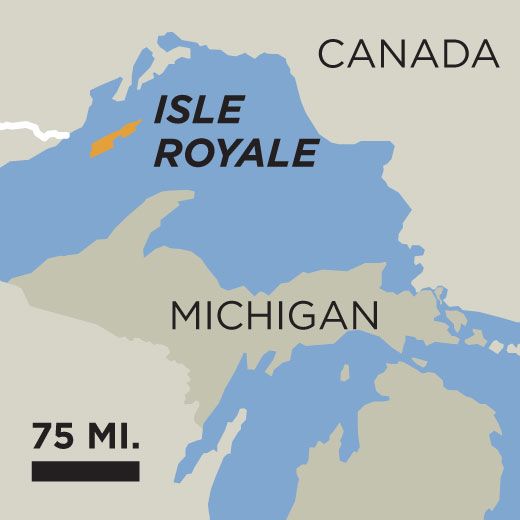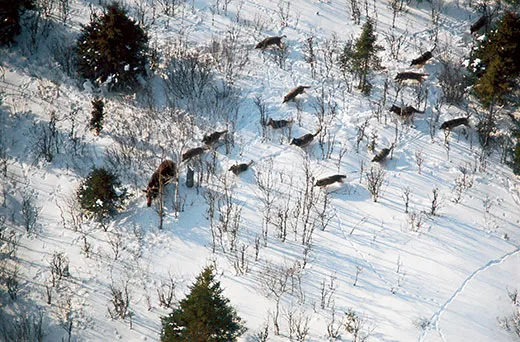Evolution World Tour: Isle Royale, Michigan
Moose and wolves face off in the world’s longest-running study of predators and prey
First came the moose. About 100 years ago, some of the animals swam or walked across ice to Isle Royale, a fir- and spruce-covered island in Lake Superior. There they found moose heaven, nothing but forage.
Next came the gray wolves. They arrived around 1950, after a cold winter allowed them to cross 15 miles of ice from the Canadian shore. They found a wolf idyll, all moose meat and a dearth of people, who had wiped out most of the wolves everywhere in the United States except Alaska.
Last came the wildlife biologists, in 1958. They wanted only to watch nature take its course. Other people had preceded the scientists—Isle Royale had been a resort in the early 20th century and part of a national park since 1940—but the biologists found their own kind of idyll, full of data to glean from a natural experiment in evolutionary biology.
The moose, the wolves and the biologists are still at Isle Royale National Park, collaborating on what has become the world’s longest-running study of relations between a predator and its prey. “We have found that ecology is really a historical science,” says Rolf Peterson, who has been with the study since 1970. Over time, “unpredictable, rare events completely change everything that follows.”
Islands, as Charles Darwin discovered in the Galápagos, make good laboratories for studying evolution. For one thing, they have discrete ecosystems, which present fewer variables to sort out—fewer species, fewer individuals, fewer interrelationships. For another, islands are self-contained. A fox, say, on California’s Channel Islands (known as “America’s Galápagos”) is easier to study because it can’t sneak off to someplace new. Isle Royale, at about 45 miles long and 9 miles wide, is big enough to support moose and wolves but small enough that biologists can keep track of them, following their footprints or surveying them from the air.
Researchers from what is formally known as the Isle Royale Wolf-Moose Study have made fundamental observations of how this particular pairing of predator and prey has evolved in response to each other. Peterson has noted that while a wolf pack is an impressive killing machine, an adult moose does not go gently into that good night: “An old forest with lots of downed trees also allows a moose to ‘comb’ the wolves from its backside by running or twirling around and violently throwing them against trees,” he wrote in The Wolves of Isle Royale: A Broken Balance. “This behavior helps explain the broken ribs often found in the skeletons of old wolves on Isle Royale.”
John Vucetich, who leads the study with Peterson, has data suggesting that as the wolves have preyed on smaller moose—which are easier to bring down—they have influenced moose evolution. With big moose surviving and breeding, they tended to produce offspring that grew into big adults, meaning that the size of the average member of the herd increased. That effect might seem logical, but the Isle Royale research may be the first to document the phenomenon in a predator-prey pair in the wild. Beyond that, the study has determined that even in a simple ecosystem, the predator-prey relationship is complex. “The number of factors that determine the annual outcome of wolf-moose interaction is truly baffling,” Peterson says. The wolves have ranged in number from 12 to 50, and the moose from 385 to 2,422—and those numbers have not always risen and fallen in tandem. Plant life, weather and disease dramatically affect both populations.
For example, from the peak of 50, reached in 1980, the wolf population crashed to 14 by 1982, despite a relatively stable population of moose. The cause turned out to be canine parvovirus, which came to the island via a dog. The moose numbers rose steadily while the wolf numbers recovered, hitting that peak of 2,422, in 1995. Then more than half of the moose starved during the bitter winter of 1995-96.
More recently, warmer weather has led to higher numbers of moose ticks, which led to weaker moose, which led to easier kills for wolves. Meanwhile, the wolves have shown a high incidence of a backbone malformation from inbreeding. In 2010, the study determined that a new alpha male had migrated to Isle Royale in 1997, which might have refreshed the gene pool if he hadn’t initiated a genetic sweep of his own by breeding so prolifically with the local females. As of 2007, all Isle Royale wolves are related to him. The most recent concern, Vucetich says, is a dearth of females: There are now no more than two left on the island.
In the meantime, humans will keep coming to Isle Royale National Park, for recreation as well as research. The park is open from April through October; visitors can take ferries from ports in Minnesota and Michigan. The wolf-moose study offers research expeditions for non-scientists and weeklong forays into the wilderness to collect moose bones. The world’s longest-running predator-prey study is far from finished.
/https://tf-cmsv2-smithsonianmag-media.s3.amazonaws.com/accounts/headshot/tom-frail-head-shot.jpeg)


/https://tf-cmsv2-smithsonianmag-media.s3.amazonaws.com/accounts/headshot/tom-frail-head-shot.jpeg)